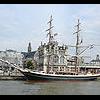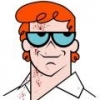-
Posts
13,093 -
Joined
-
Last visited
Reputation Activity
-
 druxey got a reaction from Chasseur in Modeling the Extreme Clipper Young America 1853
druxey got a reaction from Chasseur in Modeling the Extreme Clipper Young America 1853
If you're building models, Clare, you don't need cable. I've been without it for some years now and don't miss it! On the other hand, I need to buy more book shelves....
-
 druxey reacted to cabrapente in Le Francois by cabrapente
druxey reacted to cabrapente in Le Francois by cabrapente
an absurd ruling.
the map. 13, it was not in place, and put the buzardas, without placing the liner ...
I have taken away --- I have a doubt: the inner liner, ¿Continuous the way up by the lateral uninterruptedly?
one cabrapente greeting
-

-
 druxey reacted to Mahuna in Modeling the Extreme Clipper Young America 1853
druxey reacted to Mahuna in Modeling the Extreme Clipper Young America 1853
Ed - I just received my copy - thank you! The only problem is - I'll be reading your book instead of finishing my current build. Oh well, life is a series of choices.
-
 druxey got a reaction from fmartins in Le Fleuron by Gaetan Bordeleau - FINISHED - 1:24
druxey got a reaction from fmartins in Le Fleuron by Gaetan Bordeleau - FINISHED - 1:24
Surely you are not going to put the model in the garbage, Gaetan! If so, let me know which night it will be put out....
-
 druxey reacted to Chuck in HM Cutter Cheerful 1806 by Chuck - FINISHED - 1:48 scale - kit prototype
druxey reacted to Chuck in HM Cutter Cheerful 1806 by Chuck - FINISHED - 1:48 scale - kit prototype
Most were just edge bent...the hooked scarfs were cut from wider stock than the 3/16" strips and then they were edge bent too!!!
Chuck
-
 druxey got a reaction from Elia in Modeling the Extreme Clipper Young America 1853
druxey got a reaction from Elia in Modeling the Extreme Clipper Young America 1853
If you're building models, Clare, you don't need cable. I've been without it for some years now and don't miss it! On the other hand, I need to buy more book shelves....
-
 druxey got a reaction from EdT in Modeling the Extreme Clipper Young America 1853
druxey got a reaction from EdT in Modeling the Extreme Clipper Young America 1853
I believe that SeaWatchBooks will be there with a range of their new publications. Bring your pocketbook, credit cards and first-born.
-
 druxey reacted to mtaylor in HMS Pandora
druxey reacted to mtaylor in HMS Pandora
Looking really fantastic, Magnus. That ship is almost alive.
-
 druxey got a reaction from dgbot in Le Fleuron by Gaetan Bordeleau - FINISHED - 1:24
druxey got a reaction from dgbot in Le Fleuron by Gaetan Bordeleau - FINISHED - 1:24
Surely you are not going to put the model in the garbage, Gaetan! If so, let me know which night it will be put out....
-
 druxey reacted to Mark P in 1760's Royal Navy deck planking and waterway nibbing patterns?
druxey reacted to Mark P in 1760's Royal Navy deck planking and waterway nibbing patterns?
Another pennyworth:
I have deck plans from the NMM of HMS Tremendous, a 74 launched in 1784. There are notes and sketches on all deck layouts, drawn by the original builder, including many of the plank seams and butts. Although unfortunately these do not show the details of any nibbing or hooking at the bow, they show quite clearly that on all decks the planking runs in tapering curves towards the bow and stern. And whilst the bow planking clearly runs into a margin plank or waterway, at the stern the number of strakes remains constant, and they all diminish. At both bow and stern the outermost planks have much more curvature than those nearest the centre.
All the best,
Mark P
-
 druxey got a reaction from CiscoH in HM Cutter Cheerful 1806 by Chuck - FINISHED - 1:48 scale - kit prototype
druxey got a reaction from CiscoH in HM Cutter Cheerful 1806 by Chuck - FINISHED - 1:48 scale - kit prototype
Nice to see the deck planking done as it actually was in those days! No excuses any more, folks....
-
 druxey got a reaction from Piet in SS Andrea Doria 1952 by shipmodel - FINISHED - 1/16" scale
druxey got a reaction from Piet in SS Andrea Doria 1952 by shipmodel - FINISHED - 1/16" scale
Clever work on mounting and stabilizing the boats, Dan.
-
 druxey got a reaction from GLakie in Modeling the Extreme Clipper Young America 1853
druxey got a reaction from GLakie in Modeling the Extreme Clipper Young America 1853
I believe that SeaWatchBooks will be there with a range of their new publications. Bring your pocketbook, credit cards and first-born.
-
 druxey got a reaction from Jack12477 in Modeling the Extreme Clipper Young America 1853
druxey got a reaction from Jack12477 in Modeling the Extreme Clipper Young America 1853
If you're building models, Clare, you don't need cable. I've been without it for some years now and don't miss it! On the other hand, I need to buy more book shelves....
-
 druxey reacted to Chuck in HM Cutter Cheerful 1806 by Chuck - FINISHED - 1:48 scale - kit prototype
druxey reacted to Chuck in HM Cutter Cheerful 1806 by Chuck - FINISHED - 1:48 scale - kit prototype
No not yet. That is months away I am afraid. I am using MinWax Wipe-On-Poly for the finish. Nothing else.
Started on the timber heads today. There are only six. No shortcuts here. Just grab a sharp blade and start shaping. I know some folks use power tools for this but I prefer to go old-school. I just go very very slow. They are 3/32" thick.
Chuck
-
 druxey got a reaction from shipmodel in SS Andrea Doria 1952 by shipmodel - FINISHED - 1/16" scale
druxey got a reaction from shipmodel in SS Andrea Doria 1952 by shipmodel - FINISHED - 1/16" scale
Clever work on mounting and stabilizing the boats, Dan.
-
 druxey got a reaction from mtaylor in HMS Atalanta 1775 by tlevine - FINISHED - 1:48 scale - from TFFM plans
druxey got a reaction from mtaylor in HMS Atalanta 1775 by tlevine - FINISHED - 1:48 scale - from TFFM plans
Certainly there are a number of tricks to learn when centering anything in an independent 4-jaw chuck!
-
 druxey got a reaction from mtaylor in SS Andrea Doria 1952 by shipmodel - FINISHED - 1/16" scale
druxey got a reaction from mtaylor in SS Andrea Doria 1952 by shipmodel - FINISHED - 1/16" scale
Clever work on mounting and stabilizing the boats, Dan.
-
 druxey got a reaction from avsjerome2003 in Frégate d'18 par Sané , la Cornélie
druxey got a reaction from avsjerome2003 in Frégate d'18 par Sané , la Cornélie
Oh, excellent! Much more filling than an amuse-bouche! Bon appetite, monsieur.
-
 druxey got a reaction from Canute in SS Andrea Doria 1952 by shipmodel - FINISHED - 1/16" scale
druxey got a reaction from Canute in SS Andrea Doria 1952 by shipmodel - FINISHED - 1/16" scale
Clever work on mounting and stabilizing the boats, Dan.
-
 druxey got a reaction from Omega1234 in SS Andrea Doria 1952 by shipmodel - FINISHED - 1/16" scale
druxey got a reaction from Omega1234 in SS Andrea Doria 1952 by shipmodel - FINISHED - 1/16" scale
Clever work on mounting and stabilizing the boats, Dan.
-
 druxey got a reaction from mtaylor in Frégate d'18 par Sané , la Cornélie
druxey got a reaction from mtaylor in Frégate d'18 par Sané , la Cornélie
Oh, excellent! Much more filling than an amuse-bouche! Bon appetite, monsieur.
-
 druxey got a reaction from michael mott in Le Fleuron by Gaetan Bordeleau - FINISHED - 1:24
druxey got a reaction from michael mott in Le Fleuron by Gaetan Bordeleau - FINISHED - 1:24
Surely you are not going to put the model in the garbage, Gaetan! If so, let me know which night it will be put out....
-
 druxey reacted to JohnE in Frégate d'18 par Sané , la Cornélie
druxey reacted to JohnE in Frégate d'18 par Sané , la Cornélie
Truer words were never spoken, druxey. I've been trying to model the stern (estain and ecussons) in 3D and then identify a plane and rotate things so they are rectilinear and I can take offsets. Woof ! Painful ! So I was rereading Vial and rediscovered the rest of his entire section on designing the stern. Was so intent on the wonderful hors-d'oeuvres, or the fish entrée, I neglected the perfectly cooked leg of lamb, plat principal.
There's lengths, angles, detail up the wazoo, along with a nice description as to how it will project on a 3-view and an even nicer description as to the effects on a ship's lines by moving certain of the marks in-or-out, up-or down, fore-or aft.
Dude, can you say Homer Simpson moment? Du' Ohh !
Moving along, Vial's stuff is for a 74, but the concept is still good for a frigate with some adaptation as to to scale. Will be paying more attention to Monsieur Vial in the future.
John















